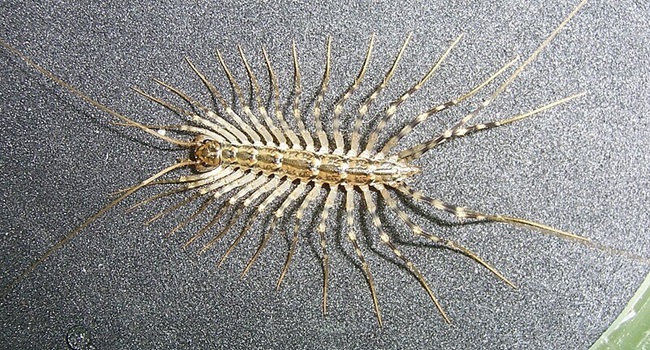When my mind wanders, I sometimes consider where house centipedes lived before we built houses? Were they cave dwellers? Did they hunt ants in hollow logs? Or perhaps, they were found in the dried-out carcasses of deceased dinosaurs?

Regardless of their past lives, house centipedes (Scutigera coleoptrata) now live exactly where their names suggest: in our houses. But before you reach for the rolled-up magazine, or perish the thought, the shop vac, consider that this is one leggy friend worth tolerating or even encouraging in your dwelling.
House centipedes at a sideways glance appear like a dust bunny, but on closer inspection you are likely to notice that it is the fastest-moving dust bunny you are ever likely to encounter. This amazing myriapod manages to coordinate 15 pairs of long legs to move as fast as an inch-long train along your trim board in search of prey.
And the prey would be the reason to keep this invertebrate in your house. When house centipedes are not hiding in the humid corners of your garage or basement, they devote time to search and destroy missions targeting the actual pests in your house. House centipedes snack on cockroaches, ants, carpet beetles, and maybe even a few bed bugs. So, if silverfish are too fast for you to catch and remove, perhaps leave it to a faster moving animal that evolved to catch them.
When my children were in grade school, the teachers knew I was a bug guy and occasionally I was asked to deal with the scary bug that got trapped in the classroom sink. It was nearly always a house centipede. While some parents might have drowned or squashed the hapless beasties, I discretely liberated them to hunt another day. And for teachers who were interested, I explained how a yard stick or even a draped paper towel would be a perfect escape route.
To an extent, I understand the repulsion that some feel toward leggy arthropods, and if this is your irrational fear (no judgement), house centipedes are likely to be a really strong trigger. Although these invertebrates max out at body lengths of 1.5”, the back pair of legs stick out at least that far again, and the antennae can exceed twice the body length extending this invertebrate’s forward reach. Putting all that leggyness together gives the appearance of an impressive 4- or 5-inch specimen…. running rapidly across your mudroom floor or up the wall. “Unnerving” comes to mind.
Of course, these spectacular little runners don’t start out life living large. When they hatch, they are tiny eight-legged predators going after the smallest of the invertebrates in your home or mine. But as much as I am interested in such critters, and as hard as I have looked in basement corners and, I admit it, through the dust bags of multiple vacuum cleaners, I have yet to see a baby at the 8-leged stage. Regardless of my fruitless quests, these juvenile centipedes chomp through a few scores of dust mite-sized prey before shedding their exoskeletons and growing to the next phase. With each shedding of its exoskeleton, a growing house centipede adds a pair or two of legs until it reaches the maximum number of 15 pairs. Like other centipedes, they have just 1 pair of legs per segment.
Even when they have achieved a count of 30 legs, the centipedes are not quite adult. They undergo four more molts, each liberating a slightly larger centipede from the husk of its former self, until the final molt reveals a fully adult centipede. The centipedes can live for years and have over 100 offspring. That should be more than enough little predators to keep the pantry moths under control in your abode.
American houses have not always been graced by the presence of house centipedes. Like many common invertebrates, house centipedes were introduced from overseas at least by the 1800s and are widespread across the continent. Unlike many exotic species, house centipedes don’t tend to become invasive, and not problematic.
In fact, the only way a house centipede could be induced to cause you anything even approaching harm, would be if you picked one up and held it in your hand. And if handling a multi-legged invertebrate is something to which you aspire, you can anticipate that it might bite you. If you have the speed and agility to catch one without squishing it, I’m told that the bite produces mild swelling, redness, and temporary pain. But all this unpleasantness can be avoided by skipping the opportunity to catch one in your hand! Perhaps just leave it be to munch on less interesting critters?
Declan McCabe is a professor of biology at Saint Michael’s College. His forthcoming book, Turning Stones: Discovering the Life Of Water is available for pre order through Down East Books at DownEastBooks.com or where ever you find your books.




Comment here